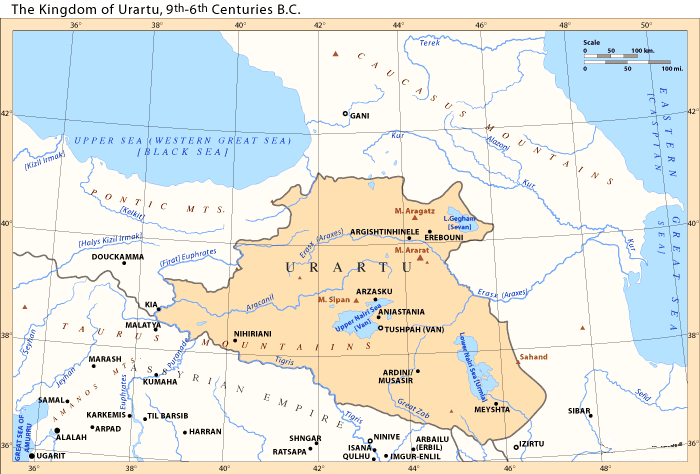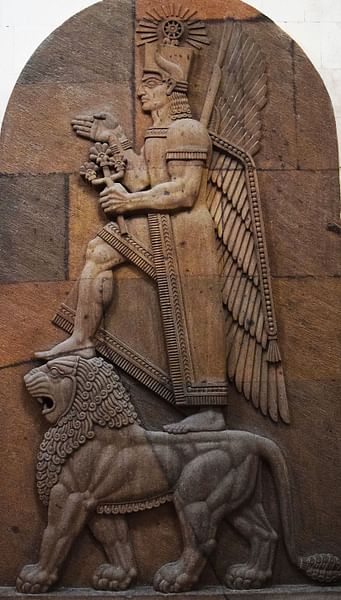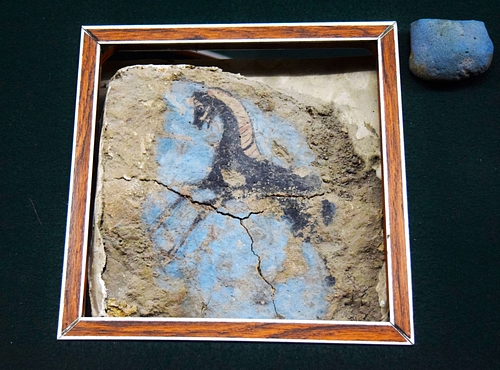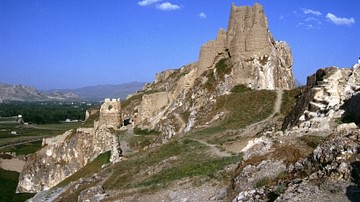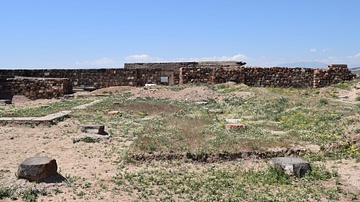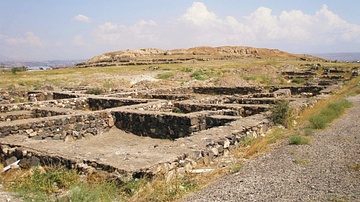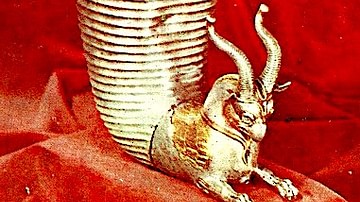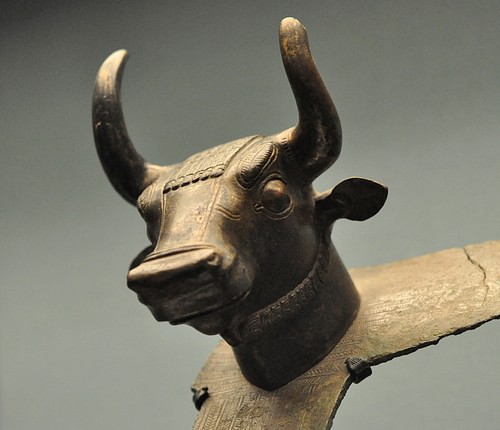
Urartu, also known as the Kingdom of Urartu or the Kingdom of Van, was a civilization which developed in the Bronze and Iron Age of ancient Armenia, eastern Turkey, and northwestern Iran from the 9th century BCE. Controlling territories through military might and the construction of fortresses, the kingdom boasted a lively production in the arts, especially metalwork. Surviving only two centuries, the kingdom mysteriously disappeared in the 6th century BCE and was only rediscovered as a distinct and recognisable ancient culture by excavations carried out in the 19th century CE.
The history of Urartu remains fragmentary due to a lack of extended written sources and an overreliance on potentially biased sources from contemporary enemy states such as Assyria. Nevertheless, surviving inscriptions, architecture, and artefacts, together with ongoing archaeological investigations have helped re-create a sufficiently detailed history to indicate the undoubted importance of one of the region's most influential ancient cultures.
Names
'Urartu' comes from urashtu, the Assyrian word for the kingdom, and signifies “high place”, possibly referring to either the mountainous region or the culture's common practice of building fortifications on rock promontories. To the Babylonians they were uruatri, and to the Hebrews the kingdom was known as Ararat. The Urartians called themselves Biaina and their state Biainili (or Land of the Nairi).
Prosperity
Urartu sprang from a confederation of kingdoms which had developed from the 14th or 13th century BCE onwards. A recognisable and independent state known as Urartu developed from the 9th century BCE which combined these smaller kingdoms, probably in response to an external threat from Assyria. The culture prospered thanks to settlement on the extensive fertile plateau which was well-supplied by rivers. Crops included wheat, barley, millet, rye, sesame, and flax. Viticulture was also important, wine-making in the region perhaps being the earliest anywhere (although there are other candidtates). Remains of fruit found at Urartu sites include plums, apples, cherries, quinces, and pomegranates.
Animal husbandry prospered thanks to excellent mountain pastures, and sheep, goats, cattle, and horses were all bred. Mineral deposits in the area included gold, silver, copper, lead, iron, and tin. The location on the trade routes between the ancient Mediterranean and Asian and Anatolian cultures was another source of prosperity. Although protected by mountains in the north and south, defence was perpetually necessary against attackers from the east and west eager to capitalise on the region's wealth.
Government & Territory
The government of Urartu functioned around a centralised monarchy with a close circle of advisers and a much larger group of civil administrators who supervised temples and such construction projects as fortresses, roads, and canals. The fortress capital, Tushpa, was built on a limestone promontory on the eastern shores of Lake Van in the highlands. Tushpa would later be called Van and perhaps had a population as high as 50,000 at its peak. The capital also had a royal necropolis composed of chambers cut into the mountain on which the city was built. Other surviving remains include an open-air shrine with smooth walls and many inscriptions made into the rock. Regional governors represented the king in the provinces, administered justice, and collected taxes in kind, which were channelled back to the capital.
The kingdom's first known monarch was Arame who reigned c. 860-840 BCE. Assyrian sources mention that the kingdom first rose to prominence from c. 830 BCE under the king Sarduri I (r. c. 835-825 BCE) whose descendants would rule for the next two centuries. In 776 BCE, Argishti I (r. c. 785-760 BCE) would found a new city, Argishtihinili, on the Plain of Ararat, later to become the second city of the kingdom and renamed Armavir. Then, c. 685 BCE, king Rusa II (r. c. 685-645 BCE) founded the important northern city of Teishebaini (modern Yerevan), also on the Ararat plain. Other important Urartu centres were Bastam, Karmir Blur, Adilcevaz, and Ayanis.
The state controlled large areas of agricultural production thanks to annual campaigns by its army and a network of fortresses. The policy of rulers towards weaker neighbouring tribes was sometimes one of confederation and the extraction of tribute in the form of goods and slaves rather than conquest. However, there are notable cases of the seizure of slaves such as Argishti I's campaigns against the Hatti and Dsopk in the 780s BCE when he was said to have captured 320,000 slaves. By the 7th century BCE, Urartu thus controlled territory which stretched from the Caspian Sea to the Upper Euphrates (east to west) and the Caucasus mountains in the north to the Taurus Range in the south. However, the exact territorial coverage is not agreed upon by scholars.
Warfare
All Urartu kings seem to have led their armies in battle. Weapons, as indicated by those dedicated at temples, included iron and bronze swords, spears, and javelins, as well as bows. Heavy shields were used which had large central bosses decorated with images of mythical creatures, bulls, and lions. There is also evidence of helmets and metal scale armour, at least worn by the elite. The chief adversary was the Neo-Assyrian Empire, although there is also evidence of trade relations between the two states. Given the use of chariots by the Assyrians, it would seem reasonable to suppose that their adversary also employed them, especially given the Urartians fame for horse breeding. Urartu did enjoy some victories in the mid-8th century BCE, but the Assyrian ruler Tiglath-Pileser III (r. 745-727 BCE) was more aggressive than his predecessors and he laid siege to Tushpa. Another significant conflict between the two states was during the campaign of Sargon II (722-705 BCE) in 714 BCE. Other enemies of Urartu included the Cimmerians, Scythians, and finally the Medes.
Religion
Offerings of food, weapons, and precious goods, libations of wine, and animal sacrifices were all made to the gods in dedicated outdoor ritual spaces and at false doorways carved into rock faces which were known as “Gates to the Gods”. The pantheon of the Urartu religion contains a mix of unique and Hurrian gods such as the god of storms and thunder Teisheba, from the Hurrian Teshub. The mid-9th century BCE king Ishpuini promoted Haldi (Khaldi) to the head of the gods, a deity of foreign origin, although his role and function are obscure besides that he was associated with warfare. Haldi is often portrayed as a man standing on a bull or lion, symbolic of his power.
Haldi, in particular, had temples built in his honour, which have distinctive square towers with reinforced corners. So important was this god that the Urartians were sometimes called the Haldians or “children of Haldi”. The ruling king was known as the “servant of Haldi” and all wars were carried out in his name.
Another important deity was Shivani, the Sun god who, given his representation with a winged solar disk, was likely inspired by the Egyptian god of the same association, Ra. The consort of Haldi, Arubani, was the most important female goddess; Sielardi was the moon goddess, and Sardi a star goddess. Urartu art includes the Tree of Life symbol common to Mesopotamian cultures and is usually shown with a figure stood either side making offerings.
Architecture
The Urartians were innovative and ambitious architects. Significant construction projects include the 80-kilometre long stone-lined canal which brought fresh water from the Artos mountains to the capital. The structure was built by king Menua (r. c. 810-785 BCE) and allowed the proliferation of vineyards and orchards resulting in Tushpa gaining a reputation as a garden city.
Although few structures survive today, an example of an Urartu temple can be seen in a relief in the palace of the Assyrian king Sargon. The relief shows the temple of Haldi at Ardini before it was sacked by the Assyrians in 714 BCE. The building has a hexastyle portico (six-columned facade) and triangular pediment, shields hang from the exterior walls and a great urn stands either side of the entrance.
Although little remains of Urartu fortifications, one of the most significant and best-preserved fortresses is at Erebuni near today's capital of Armenia, Yerevan. Built during the reign of king Argishti I, impressive sections of the fortification walls still stand today. Typical features of Urartu fortifications are massive walls supported by stone foundations made of large square blocks and buttressed with towers. In Assyrian reliefs of Urartu fortifications, these towers are crenellated and have windows. Their survival since antiquity is a testimony to the building skills of the Urartians, especially considering the region is subject to frequent and powerful earthquakes.
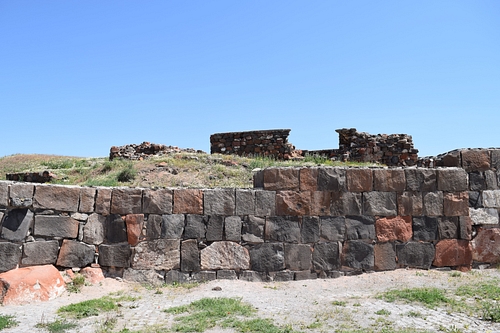
Palace buildings are composed of multiple chambers and larger halls, the former usually with the roof supported by a centrally placed wooden column and the latter by multiple rows of columns. Other features are open courtyards and storerooms where large pottery jars were sunk into the floor to hold foodstuffs, wine, and beer. The larger examples of these sunken jars have a capacity of around 750 litres (200 gallons) each. Structures located away from residential buildings, probably because of the fire risk, include potteries and smelting kilns.
Materials used include large “cyclopean” blocks placed together without mortar, worked stone blocks, and mud bricks. Roofing was made using wooden beams or barrel vaults of adobe bricks. Flooring was of stone in the more prestigious buildings with surviving examples having either large basalt slabs or even large-stone polychrome mosaics with geometric designs. Interior walls could carry frescoes, and sometimes they also had cavities cut into them into which were placed decorative bronze plaques or cut stone slabs in red, white, or black. Doors were made from thick planks of wood and locked using a hinged bronze latch.
MATERIAL CULTURE
The wealth and prosperity of Urartu is attested by ample surviving evidence of its material culture, notably pottery, objects utilised as religious dedications, and examples of bronze-working. No large-scale stone sculptures survive except in fragments. Excavations have revealed both public and private buildings in Urartian cities with interior wall paintings. Painted on plaster, surviving fragments show scenes with animals, mythical creatures, processions of gods, and scenes from everyday life such as agriculture and hunting. Backgrounds are usually white, outlines are drawn in black, and blue and red are the most commonly used colours.
Metalworking has a long history in the region, dating back to the 10th centruy BCE. Artisans in the Urartu kingdom produced such goods as jewellery, horse bits, helmets, buckles, and candelabra in bronze and copper. Large bronze cauldrons with animal or human heads around the rim were produced in numbers. Metal goods were cast, embossed, inlaid with gold or etched with designs. Urartu art is best seen in bronze sculptures made in the round which show an influence from Assyria, particularly in the choice of subjects - lions, bulls, mythological creatures such as griffins and centaurs, and military themes, especially horse riders. Religious art includes bronze figurines of prominent gods such as Haldi, Teisheba, and Shivani. Some deities are unidentified such as a female goddess rendered in bone and hybrid figures of a fish-man, bird-man, and scorpion-man. Those bronze items belonging to the royal household are so identified by inscriptions which have also helped to identify Urartu works found outside Asia such as in Etruscan tombs in central Italy. Other materials used in Urartu art include ivory, semi-precious stones, and stag horns.
Early Urartu writing used simple pictograms, but cuneiform was adopted and adapted from neighbouring contemporary Mesopotamian cultures. Surviving cuneiform inscriptions from the kingdom, of which there are some 400 examples, show that the Urartian language was related to Hurrian, with the two languages probably sharing a common ancestor language dating to the 3rd or 2nd millennium BCE.
Decline
In the 7th century BCE, the Urartu kingdom came to a mysterious but violent end when sometime between c. 640 and c. 590 BCE their cities were destroyed. The state was probably weakened by decades of battles with the Assyrians, and it may have been too overstretched to control its own empire. The perpetrators are not known but the Scythians are one candidate, the Cimmerians another, and even possibly forces from within the territories administered by the Urartu kings.
Finds of three-pronged arrowheads, typical of Scythian archers, found at the destroyed site of Teishebaini are suggestive. The destruction of the city by fire sometime between 594 and 590 BCE seems to have been unexpected, with granaries recently filled and weapons and precious belongings seemingly abandoned in a hurry. It is likely that the various cities of Urartu succumbed at different times to different peoples over a period of two or three decades.
The territories the Urartu kingdom had once occupied were ultimately taken over by the Medes from c. 585 BCE onwards and then incorporated into the Achaemenian Empire of Cyrus the Great in the mid-6th century BCE. The Urartian language, however, would survive into the Hellenistic period. Many Urartian towns would become the location of important settlements throughout antiquity, and many of their Urartu names survive today. Unrecorded and unknown to ancient Greek historians, Urartu would have to wait until archaeological excavations in the 19th century CE to take its place as an important regional Bronze Age culture.
This article was made possible with generous support from the National Association for Armenian Studies and Research and the Knights of Vartan Fund for Armenian Studies.
